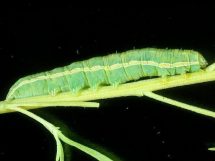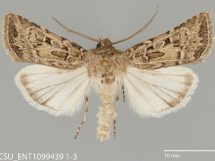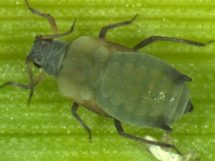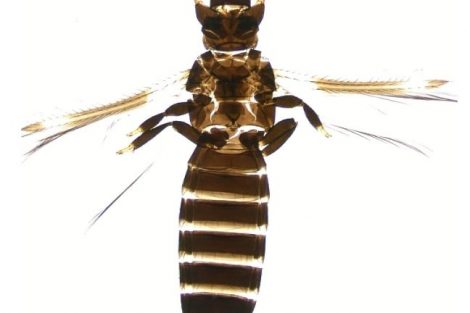Cutworms
Occurrence: Active Now, Larvae can be seen as early as late January into April. Serious infestations are sporadic.
Description: Despite their name, cutworms are caterpillars as opposed to worms. They are the larval stage of moths in the Noctuidae family (owlet moths). Utah is home to many different species. They are early-season pests of vegetable crops, especially in high tunnels. Cutworms have a wide host range including corn, tomato, beans, beet, brassicas, and leafy greens. Although cutworms get their name for their feeding behavior of cutting the stems of young seedlings, many species also feed on other plant parts. If infestations are high, seedling cutting can drastically reduce yield. In a field setting, this appears as skips or sections of rows where several seedlings are missing.
In Utah, cutworms typically overwinter in the larval stage. Larvae begin feeding early in the season on turf, weeds, and other early plants, and move to plants in gardens and fields. Adult moths are strong fliers and may disperse over a wide area. Eggs are usually laid in large clusters on stems or sometimes structures such as fences or buildings. Life duration is dependent on species and environmental factors.
|
Species |
Larva |
Adult |
| Army Cutworm Euxoa auxiliaris |
6-7 instars, 40 mm long, grayish-brown, numerous white and dark brown spots, light brown head with dark spots | 35-50 mm wingspan, wings are dark with white-rimmed spots, forewings marked with broad yellowish stripes |
| Black Cutworm Agrotis ipsilon |
5-9 instars, 45-50 mm long, light gray to black, brown head with dark spots | 40-55 mm wingspan, forewings are uniformly dark brown; hind wings are white-gray |
| Bronzed Cutworm Nephelodes minians |
6-7 instars, 35-45 mm long, distinctive shiny bronze color with 5 white-yellow stripes | 35-50 mm wingspan, red-brown, front wings with irregular dark-brown band in center of wings
|
| Clover Cutworm Discestra trifolii |
dull green, broad yellow/pink band below spiracles, black spots above the lateral band | 31-35 mm wingspan, front wings are yellow-brown with spots, hind wings gray with brown |
| Darksided Cutworm Euxoa messoria |
6-8 instars, gray with brown longitudinal lines, wavy dark band above spiracles | 30-40 mm wingspan, gray-brown front wings, hind wings are gray-white |
| Dingy Cutworm Feltia jaculifera |
6-7 instars, grayish-brown, grayish-brown head | 35-42 mm wingspan, brown, front wings are brown-gray, hind wings are uniformly brown |
| Glassy Cutworm Apamea devastator |
35-40 mm long, white-gray with brown-red head (similar appearance to white grub) | 35-45 mm wingspan, light gray to brownish-gray with a mottled pattern, narrow white line present on forewings with dark triangles on inner margin |
| Pale Western Cutworm Agrotis orthogonia |
6-8 instars, 36 mm long, gray-blue with a yellow head marked with two brown bars | 25-40 mm wingspan, attractive with yellow-brown spots on forewings with white on the veins, hindwings are white |
| Redbacked Cutworm Euxoa ochrogaster |
6 instars, gray, distinctive dark red stripe along the back separated by narrow pale stripe, yellow-brown head | 35-40 mm wingspan, dark red-brown wings with bean-shaped spots with a light border |
| Variegated Cutworm Peridroma saucia |
6 instars, brown-gray to gray-black, dorsal yellow spot present on each of the first four abdominal segments, orange-brown head with dark spots | 43-50 mm wingspan, front wings are gray-brown with hind wings are pearly white with brown veins |
| Western Bean Cutworm Loxagrotis albicosta |
5-8 instars, 35, mm long, pinkish-brown, dark brown-black stripes on thoracic plate | 35-40 mm wingspan, brown wings with a distinctive white stripe along anterior margin, well-marked spots on forewings |
Management: When properly managed, high tunnels can have a decreased incidence of cutworms. The wall structure of high tunnels can help prevent insect pests from accessing crops. The diffused light might also cause orientation problems during adult flight. A high tunnel creates a change in a microclimate that may be less favorable to pests or more favorable to natural enemies.
- When planting in high tunnels, consider interplanting. Interplanting crops with unrelated plants lower larval populations and increases beneficial wasps’ larval parasitism and predation. Predatory and parasitic wasps are attracted to the varied resources provided by a diversity of plants, including nectar and pollen in flowers and diverse insect prey.
- When bringing transplants to a high tunnel, inspect transplants carefully to ensure they are free of caterpillar eggs and larvae.
- Handpick and destroy larvae. Plant early or use early maturing varieties. Mature plants can tolerate feeding damage better than young seedlings.
- Remove plant debris both inside and outside the high tunnel at the end of the growing season, as it may serve as an overwintering site for various growth stages of caterpillar pests.
- Plant tolerant varieties. Mustard, turnip, and kohlrabi are among the more tolerant Brassicas to the diamondback moth. Glossy-green Brassica varieties that lack the normal waxy, grayish-green bloom are somewhat resistant because larvae spend more time searching, and less time feeding, on the glossy leaves.
- Tilling soil in spring or fall in the high tunnel can disrupt and destroy overwintering pupae and reduce their population for the following season. Tilling nearby cornfields at the end of the season can decrease the survival of tomato fruitworm pupae.
- Weeds growing inside or outside high tunnels can provide food sources for cutworms. Removing cool-season weeds can help starve young caterpillars. Lambsquarters and wild mustards are attractive plants for egg-laying.
- Beneficial insects are a major contributor to natural biological control. Lady beetles (Coccinellidae) and green lacewings (Chrysopidae) prey on eggs. Paper wasps (Vespidae) will feed on many small caterpillars in gardens. General predators such as shield bugs, ambush bugs, and vespid wasps also attack caterpillars, as do many birds. However, since cutworms dwell beneath the soil surface, few of these natural enemies are effective in controlling their populations.
Effective home and commercial insecticides registered for high tunnel use in Utah.
| Active Ingredient | Products |
| Carbaryl | Sevin SL |
| Malathion | Malathion 5EC |
| Pyrethrins | Pyganic (Organic) |
| Pyrethrins + azadirachtin | Azera (Organic) |
| Spinosad | Entrust (Organic) |
| Bacillus thuringiensis | DiPel ES (Organic) |
| Methoxyfenozide | Intrepid 2F |
| Burkholderia spp | Venerate CG (Organic) |
| Chroimobacterium subtsugae | Grandevo (Organic) |
| Azadirachtin | Aza-Direct (Organic) |
| Zeta-Cypermethrin | Garden Tech Sevin |
| Cyfluthrin | BioAdvanced Vegetable and Garden Insect Spray |
| Permethrin | Bonide Eight |
| Pyrethrins + insecticidal soap | Safer Brand Tomato & Vegetable Insect Killer (Organic) |
Aphids
Occurrence: Active Now, Overwintering are eggs hatching. Present in controlled environments like high tunnels and greenhouses.
Description: Aphids are small plant-feeding insects in the order Hemiptera (the “true bugs”). Like all true bugs, aphids have a piercing-sucking mouthpart (“proboscis”) that is used for feeding on plant structures. In general, aphids are pear-shaped, soft-bodied, and possess a characteristic pair of cornicles on the posterior end of their abdomen, allowing for easy identification.
The life cycle of aphids is complex and can vary among species. In general, aphids overwinter as eggs. In the spring, eggs will hatch into first instar nymphs and are usually all females. They will begin to feed on host plants and will grow into subsequent nymphal stages. There are four nymphal stages prior to molting into the adult stage. The complete development of aphids can be very short, sometimes only taking a few days to hatch and grow to the adult stage.
Common species of aphids found on Utah’s vegetables
- Green peach aphid (Myzus persicae)
- Melon aphid (Aphis gossypii)
- Cabbage aphid (Brevicoryne brassicae)
- Potato aphid (Macrosiphum euphorbiae)
- Black bean aphid (Aphis fabae)
- Corn leaf aphid (Rhopalosiphum maidis)
- Cowpea aphid (Aphis craccivora)
- Honeysuckle aphid (Hyadaphis foeniculi)
- Currant-Lettuce aphid (Nasonovia ribisnigri)
- Lettuce root aphid (Pemphigus bursarius)
- Pea aphid (Acyrthosiphon pisum)
- Plum-Thistle aphid (Brachycaudus cardui)
- Turnip aphid (Lipaphis erysimi)
- Willow-Carrot aphid (Cavariella aegopodii)
Management: High tunnels create a protected environment that also extends the growing season. These ideal conditions are great for production but also favorable for aphid pests. Inside high tunnels, there tend to be both winged and wingless forms of aphids. They are often all asexually reproducing females. Monitoring for aphids should happen weekly throughout the season, from the seedling stage through harvest.
- Visually inspect plants for aphid colonies, feeding symptoms on growing tips, and curled leaves. Most aphid species prefer the undersides of leaves, so be sure to turn foliage over when scouting. Use a 10-20x hand lens for species identification.
- Look for small white flakes, which are the shedded skins of aphids.
- Yellow sticky traps are effective to monitor for the presence of winged aphids. Place traps 4–6 inches above susceptible host plants.
- Monitor plants for various symptoms of viruses. Vegetable viruses vectored by aphids include alfalfa mosaic virus, cucumber mosaic virus, potato virus Y, and watermelon mosaic virus.
- Inspect transplants for aphids before bringing them into the high tunnel.
- Look for a sticky substance called honeydew on leaves’ stems. It is a sugary, sticky secretion from aphids. It can cause the growth of a black sooty mold.
- Monitor for the presence of ants. Ants feed on excreted honeydew from aphids, which can indicate high populations.
- Use preventive measures. Before planting inside the high tunnel, remove weeds and volunteer crops that can serve as aphid hosts.
- Encourage natural enemies. Plant strips of yarrow, alyssum, herbs, and other plants with small, attractive flowers that provide nectar and pollen for beneficial insects. However, this may take up space inside the high tunnel for cash crop production (Fig. 12).
- Inspect transplants. Before planting inside of enclosed high tunnels, examine transplants for aphids.
- Manage nitrogen levels. High levels of nitrogen fertilizers tend to encourage aphid reproduction. Use several, staggered applications of lower concentrations of nitrogen rather than a single high dose. Also, use delayed-release formulations.
- Expose the high tunnel to low temperatures. During the unused winter months, use exposure to slow down or kill off any overwintering aphids or other pests.
- There are several natural predators that feed on aphids. It is important to scout for these predatory and parasitic insects and eggs in and around your high tunnels. These natural predator populations can maintain aphids at low levels. However, predators will only show up if a food source exists, so there can be a lag time between the appearance of the aphids and the appearance of predators.
When using insecticides inside a high tunnel, always read the product label to ensure use is permitted in enclosed structures like greenhouses or high tunnels.
Insecticides should only be used when needed. Rotate among different insecticide classes between applications as aphids are prone to developing resistance. Resistance has occurred with pyrethroids for populations of green peach aphid and melon aphid in agriculturally intensive areas of the United States. Some insecticides may kill the beneficial insects mentioned above.
Effective home use insecticides registered for high tunnel use in Utah.
| Active Ingredient | Products |
| Bifentrhin | Ferti-lome Broad Spectrum Insecticide |
| pyrethrins + canola oil | Earth-tone Insect Control |
| pyrethrins + piperonyl butoxide | Bonide Pyrethrin Garden Insect Spray |
| pyrethrins + potassium salts of fatty acids (insecticidal soap) | Safer Tomato & Vegetable Insect Killer (Organic), Safer Yard & Garden Insect Killer (Organic) |
| pyrethrins + sulfur
|
Bonide Tomato and Vegetable 3 in 1, Natria Insect Disease & Mite Control, Ortho Insect Mite & Disease 3 in 1 |
| oil: canola, neem, rosemary, clove, cottonseed | Natria Multi-Insect Control (Organic), Monterey All Natural 3 in 1 Garden Insect Spray (Organic) |
| potassium salts of fatty acids (insecticidal soap) | Natria Insecticidal Soap (Organic), Safer Insecticidal Soap (Organic) |
Thrips
Occurrence: Active Now, in warm and controlled environments like high tunnels.
Description: Thrips are a common pest that can be found on many high tunnel crops, plus hundreds of weed species. They are tiny insects (1.3-1.5 mm long) that feed by scraping and sucking plant fluids from leaves, and often vector plant diseases. Two species commonly found in Utah include Western flower thrips (Frankliniella occidentalis) and Onion thrips (Thrips tabaci). Bean thrips (Caliothrips fasciatus) may also occur in the state.
Thrips species in Utah all have relatively similar life cycles. In mild climates, they overwinter as adults or larvae on both crop debris and weeds. Thrips may have multiple, overlapping generations a year, which is dependent on the temperature. The optimal temperature for thrips development is 86° F. In high tunnels where the temperature is generally warmer, thrips are able to develop at a faster rate. Adults typically survive 20- 30 days. Females will mate with males or reproduce parthenogenetically (females reproduce without male fertilization). They lay their eggs within young vegetative tissue by cutting slits and depositing them beneath the epidermis. The egg stage lasts 5-15 days.
Once hatched, the thrips will develop through two larval instars where they are often found feeding together in groups on new plant growth. Mature larvae drop to the ground to pupate either on the soil surface, under debris, or inside soil crevices.
Both larval and adult stages of thrips cause damage. They feed with “rasping-sucking” mouthparts, where they pierce plant cells and ingest xylem sap and cell contents. This causes irregular white blotches (referred to as stippling, flecking, or silvering) on foliage and flowers. Heavy feeding can cause the plant leaves to curl, twist, or become stunted. Other crop-specific symptoms include:
- Beans: buds and young leaves become distorted with brown edges
- Onion: feeding causes decreased bulb size or plant death
- Cabbage: bronze discoloration of foliage
- Tomato: small indentations develop on young fruits from thrips egg-laying
Management: In the high tunnel, thrips densities can change rapidly, so it is important to monitor for their presence at least once a week, but ideally every few days. There are a variety of ways to monitor for thrips, and using a combination of these is best.
- Visually inspect plants for feeding symptoms on foliage and flowers. Use a 10-20x hand lens to then look for thrips.
- Shake foliage or blossoms over a tray or beating sheet and count the thrips present.
- Take a portion of the plant for a destructive test by submerging it into a 2% soap/water solution, shaking it, and counting the amount of thrips floating on the surface.
- Sticky traps are effective to monitor for the presence of flying adults. Blue traps are sold strictly for thrips, but yellow traps also attract thrips, as well as a number of other pests, so either can be used. Place traps evenly throughout the high tunnel near susceptible hosts.
- Some non-crop plants can be used as early indicators of thrips presence, and monitoring can be focused on these plants rather than the entire crop. Examples of indicator plants that are highly attractive to thrips include petunia (Calypso, Super Blue Magic, Summer Madness, or Carpet Blue) and fava bean (Aquadulce). These varieties can also display early symptoms of INSV and TSWV, but they do not serve as viral hosts. Place indicator plants in-ground or in pots near the susceptible cash crop (one plant per every 20-30 feet).
- Natural predators of thrips that occur in Utah include banded thrips (Aeolothrips spp.), green lacewing larvae, predatory mites, big-eyed bugs, and minute pirate bug. However, these natural enemies may not commonly occur inside high tunnels when the tunnel is kept closed or outside temperatures are cool (fall, winter, early spring).
- The predatory mite, Amblyseius swirskii, can be purchased from insectaries and released in the high tunnel. Sachets, which are small bags containing the mites and a food source, allowing for slow but consistent release over several weeks. The bags can be hung above or on plants. Mites can also be purchased in shakers and dispensed where thrip populations are dense.
It is important to choose insecticides carefully, as an application in high tunnels may not be allowed on the product label. In addition, application in enclosed spaces may require additional personal protective equipment. Because thrips reproduce rapidly, in high numbers, and without mixing genes with males (parthenogenetically), they may develop resistance to insecticides that are applied repeatedly. This is especially true of products containing organophosphates, synthetic pyrethroids, and carbamates.
Effective home and commercial insecticides registered for high tunnel use in Utah.
| Active Ingredient | Products |
| pyrethrin | Garden Tech Worry Free, Azera (Organic), EverGreen Crop Protection |
| pyrethrin + Beuveria bassiana | BotaniGard MAXX |
| zeta-cypermethrins | Garden Tech Sevin |
| neem oil + pyrethrin | Ferti-lome Triple Action |
| spinosad | Bonide Captain Jack’s, Entrust, Success |
| insecticidal soap | Safer Insecticidal Soap (Organic), Natural Guard (Organic), M-Pede (Organic) |
| oils: neem, canola, rosemary, clvoe, and cotton-seed | Natria Neem Oil (Organic), Monterey Neem Oil (Organic), Monterey All Natural Mite and Insect (Organic), Natural Guard Neem (Organic), Ecoworks EC Botanical Insecticide (Organic), RANGO (Organic) |





































